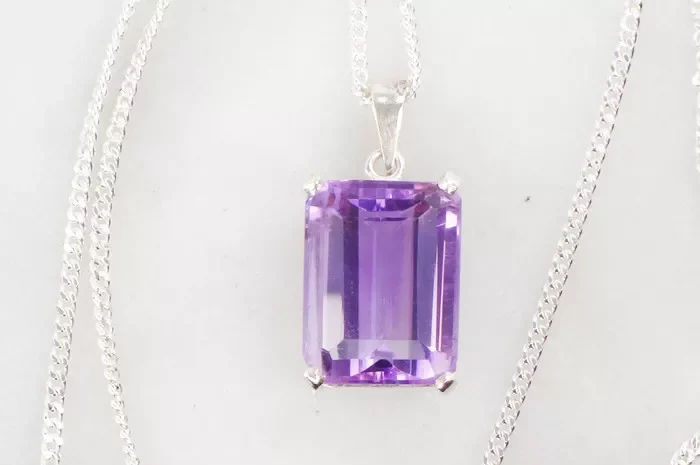Amethyst is a popular gemstone known for its beautiful purple color. It has been used in jewelry for centuries and is often associated with various properties. However, the question of whether it can be worn by everyone is a complex one that involves considering different aspects such as physical characteristics, cultural beliefs, and potential sensitivities.
Physical Characteristics
Hardness and Durability
Amethyst has a hardness of 7 on the Mohs scale. This makes it a relatively durable gemstone, suitable for regular wear in jewelry. It can withstand normal daily activities without getting easily scratched or damaged. For example, when set in a ring or a bracelet, it can hold up well during normal use, such as typing, washing hands, or light household chores.
However, compared to harder gemstones like diamonds (hardness of 10) or sapphires (hardness of 9), it is more likely to show signs of wear over time. So, for people who are very active or work in environments where their jewelry is more likely to be exposed to rough handling, amethyst jewelry may require more careful maintenance.
Color and Skin Tone Compatibility
Amethyst comes in a range of purple shades, from pale lilac to deep violet. This variety of colors means that it can be flattering for different skin tones. For fair – skinned individuals, a pale amethyst can create a soft and delicate look, while a deeper violet amethyst can add a bold contrast.
For those with medium or olive skin tones, amethyst can enhance the warmth or coolness of the skin, depending on the shade. Dark – skinned individuals can also wear amethyst beautifully, with the purple color standing out vividly against the skin. In general, the color of amethyst is versatile enough to be aesthetically pleasing for a wide range of people.
Cultural and Symbolic Beliefs
Spiritual and Metaphysical Properties
In many cultures and spiritual traditions, amethyst is believed to have certain properties. For example, in ancient Greek mythology, amethyst was thought to prevent drunkenness. In some New Age and crystal – healing beliefs, it is associated with calmness, clarity of thought, and spiritual awareness.
From a cultural perspective, if someone adheres to these beliefs, they may choose to wear amethyst for its perceived benefits. However, not everyone subscribes to such spiritual or metaphysical concepts. For those who are more skeptical, these properties may not be a factor in whether they choose to wear amethyst or not.
Cultural Taboos and Significance
In some cultures, there may be specific taboos or traditional uses of amethyst. For instance, in certain indigenous cultures, gemstones are used in specific ceremonies or are reserved for particular members of the community. However, in a globalized and modern context, these cultural restrictions are not as widespread or commonly applied to amethyst. Generally, in most Western and many other cultures, there are no major cultural barriers to wearing amethyst.
Potential Sensitivities
Allergic Reactions
While amethyst is a natural gemstone, some people may be sensitive to the metals used in the jewelry settings. For example, if amethyst is set in nickel – containing alloys, those with nickel allergies may experience skin irritation when wearing the jewelry. However, this is not a direct issue with the amethyst itself but rather with the jewelry – making materials.
To avoid such problems, it is possible to choose amethyst jewelry made with hypoallergenic metals like titanium or sterling silver (for those not allergic to silver). This way, more people can enjoy wearing amethyst without the risk of allergic reactions.
Chemical Sensitivities
Some people may be sensitive to chemicals that are used in the treatment or cleaning of amethyst. For example, if a person has a sensitivity to acids or strong cleaning agents, they need to be careful when cleaning amethyst jewelry. However, proper care instructions can usually prevent any issues. If amethyst is treated (such as heat – treated to enhance its color), it is important to know what treatments have been applied as some people may have sensitivities to the substances used in these treatments.
Conclusion
In conclusion, amethyst can generally be worn by most people. Its physical characteristics, such as its hardness and color versatility, make it suitable for a wide range of individuals in terms of aesthetics and durability. While there are cultural and symbolic aspects associated with amethyst, these do not typically pose significant barriers to wearing it in most modern cultures. Additionally, potential sensitivities such as allergic reactions or chemical sensitivities can be managed through proper jewelry selection and care. Overall, amethyst is a gemstone that offers beauty and potential significance to a diverse group of people, making it accessible for almost anyone who wishes to wear it in jewelry.
Related topic:
- Is Wearing Amethyst Suitable for Pisces?
- What Determines the Value of an Amethyst?
- How Can You Tell if Amethyst Is Natural or Synthetic?


